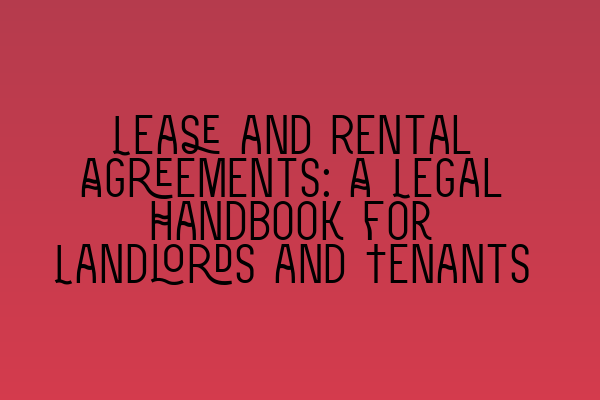Lease and Rental Agreements: A Legal Handbook for Landlords and Tenants
Renting a property can be an exciting and fulfilling experience, but it comes with its fair share of responsibilities. Whether you are a landlord or a tenant, understanding the intricacies of lease and rental agreements is crucial to ensure a smooth and mutually beneficial relationship. In this comprehensive handbook, we will delve into the key aspects of lease and rental agreements, covering everything from their purpose, essential clauses, to common legal issues that may arise. So, let’s get started.
1. Understanding Lease and Rental Agreements
A lease or rental agreement is a legally binding contract between a landlord and a tenant, outlining the terms and conditions of the rental arrangement. It establishes the rights, obligations, and responsibilities of both parties involved. Typically, a lease agreement is for a fixed term, such as one year, while a rental agreement is more flexible and may be month-to-month.
The agreement should clearly define important details, including the rental amount, payment due dates, duration of the tenancy, security deposit requirements, pet policies, maintenance responsibilities, and any other rules applicable to the property. It is essential for both landlords and tenants to carefully review the agreement before signing to avoid any misunderstandings or disputes in the future.
2. Essential Clauses in Lease and Rental Agreements
While lease and rental agreements may vary, several clauses should be included to ensure clarity and protection for both parties. These clauses may include:
- The parties involved (landlord and tenant)
- The property address and description
- The term of the tenancy
- Rent amount and payment terms
- Security deposit amount and refund procedures
- Responsibilities for repairs and maintenance
- Rules and regulations regarding pets, smoking, and noise
- Procedures for termination or renewal of the agreement
- Dispute resolution mechanisms
Including these essential clauses in your lease or rental agreement is crucial to protect both parties’ rights and ensure a successful tenancy. Additionally, it is essential to adhere to local and state laws when drafting the agreement to ensure its enforceability.
3. Common Legal Issues
Although lease and rental agreements aim to establish a harmonious relationship between landlords and tenants, disputes may still arise. It is important to be aware of common legal issues that may occur and understand how to handle them effectively.
Some common legal issues include:
- Non-payment or late payment of rent
- Unauthorized pets or subletting
- Property damage beyond normal wear and tear
- Failure to maintain the rented property
- Illegal activities conducted on the premises
- Early termination of the lease
In case of a dispute, it is advisable to seek legal advice and explore mediation or arbitration options before escalating the matter to court. Resolving issues amicably can save both time and money for all parties involved.
4. Conclusion
Lease and rental agreements play a crucial role in ensuring a positive and mutually beneficial relationship between landlords and tenants. Understanding the purpose, essential clauses, and common legal issues can empower both parties to navigate the rental process with confidence and avoid potential conflicts. If you need assistance with drafting or reviewing your lease or rental agreement, don’t hesitate to consult with a legal professional to ensure compliance with applicable laws and regulations.
For more information on legal topics and exam preparation, check out these related articles:
- SQE Sample Papers: Practice for Exam Success
- Peer Discussions Post-Mock: Learning from Collaboration and Feedback
- Adjusting Strategy Based on Mock Performance: Improving Your Approach
- Strengthening Weak Areas in SQE: Targeted Practice for Improvement
- Effective Revision Techniques for SQE: Maximizing Retention and Recall
